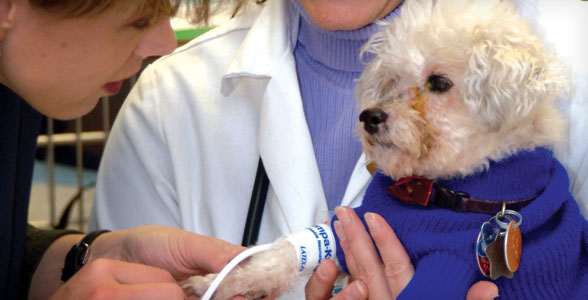Like the owner of a new car, Dr. Robert DeNovo, associate dean for administration and clinical programs at the UT College of Veterinary Medicine in Knoxville, is a little protective of the new 32,000-square-foot John and Ann Tickle Small Animal Hospital.
Construction on the $10-million project began in February 2007. DeNovo says it was a long time coming and took long-term planning, squirreling away funds, and building revenues. “We’ve done this with the support of generous donors and friends and sound fiscal management that allowed us to develop a business plan to fund this,” DeNovo says.
With the snip of a ribbon last April, the expansion was open for business. When the college was built more than 30 years ago, no one anticipated that the facility would need to accommodate the approximately 15,000 small animals treated each year. Since 1978, the patient caseload has increased by more than 70 percent. Dr. Leon Potgieter, the college’s interim dean, says the hospital’s activities had long since outgrown the available space.
“We have needed this expansion for a long time to better serve our clients and to provide a better teaching environment for our students; state-of-the-art clinical services are difficult to provide in severely cramped quarters.”
Besides an isolation suite for small animals with infectious diseases, the expansion includes medical oncology, radiation oncology, and canine physical and rehabilitation therapy, as well as avian and zoological medicine.
Among other disciplines, the college has a national reputation in avian–zoological medicine and canine physical rehabilitation and therapy. According to DeNovo, “The facility will allow the college to push the bar of contemporary educational standards to a new level.”
As animals age, their likelihood of being diagnosed with cancer increases, and the expansion provides room to accommodate an already increasing caseload. Previously, medical and radiation oncology services were spread throughout the building. Now the services are side-by-side, fostering more collaboration and providing excellent teaching opportunities.
Radiation oncology includes the only linear accelerator for veterinary use in Tennessee. The $1.5-million machine generates precisely shaped beams to irradiate tumors. Compared with older cobalt units, treatment time is a matter of seconds rather than minutes.
The college is still working to secure funding to renovate its intensive care unit and to expand its large animal teaching hospital.
Dr. Joe DiPietro, UT vice-president for agriculture, says the veterinary hospital matches the caliber and class of the people who work there. “The veterinary program, like all programs at UT, is another window to the public,” he says.
“Clients who come here see the university in a different light, and it’s important they see we’re on the cutting edge of veterinary medicine.”



